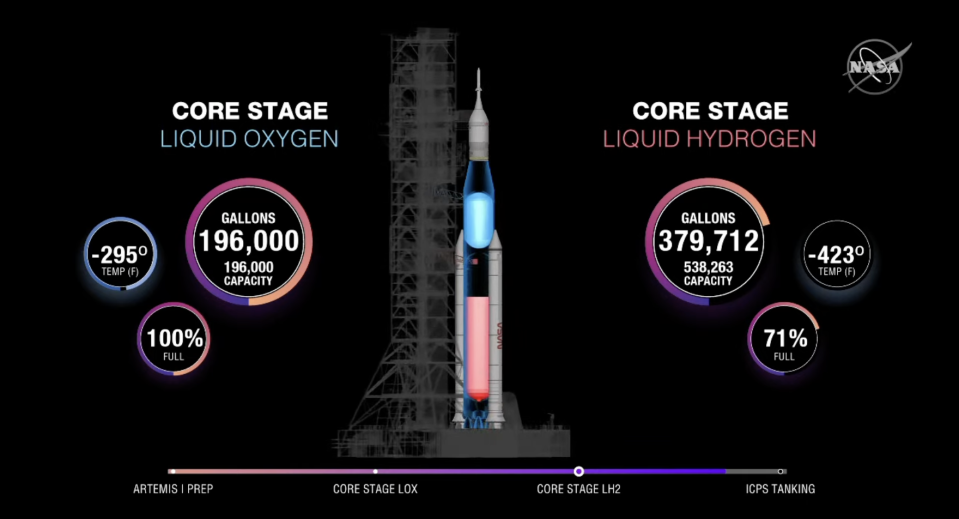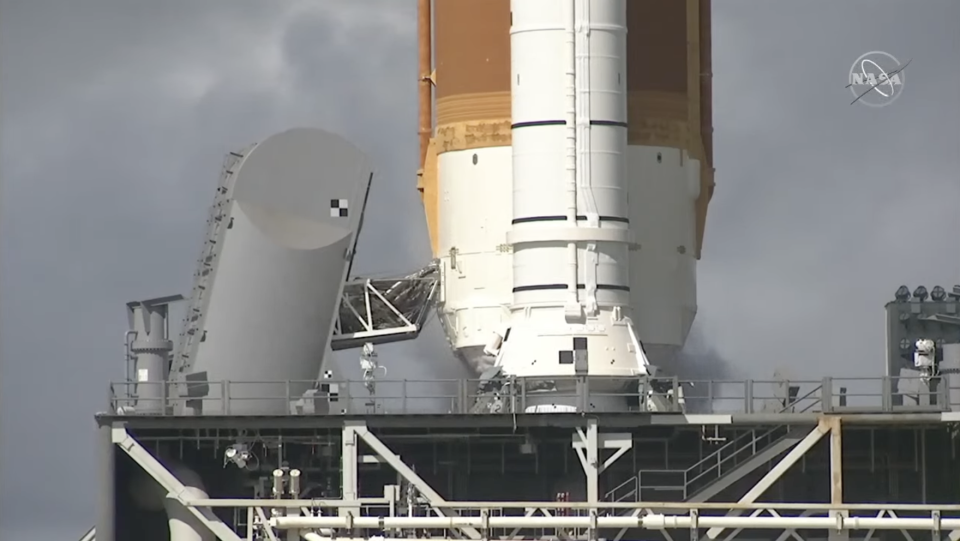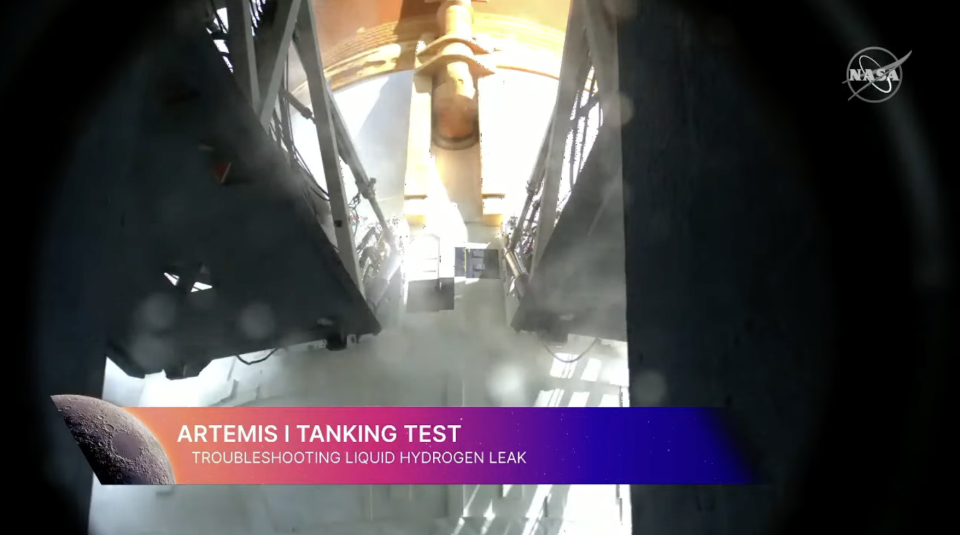Live: Watch NASA conduct Artemis I fueling test before next launch attempt
Space is important to us and that’s why we're working to bring you top coverage of the industry and Florida launches. Journalism like this takes time and resources. Please support it with a subscription here.
---
Follow live as NASA targets early Wednesday, Sept. 21, for a Space Launch System rocket fueling test at Kennedy Space Center in Florida.
The test, which will load liquid oxygen and hydrogen into the 322-foot rocket's core stage, is necessary before proceeding with the next attempt at launching the Artemis I mission to the moon. Two previous attempts in late August and earlier this month were scrubbed due to hardware issues.
NASA hopes this test, which will run into the afternoon, will
If everything goes according to plan, today's test will fully load fuel and pave the way for launch during a 70-minute window that opens at 11:37 a.m. EDT Tuesday, Sept. 27.
Teams hope to have a completed loading test by this afternoon.
Follow live updates below (manual refresh required; for more frequent, real-time updates, follow this link):
SLS now fully fueled
3:45 p.m. EDT: SLS is now fully fueled. A hydrogen leak is still being detected, but this is a big milestone regardless. Teams obviously have some more work to do to figure out the leaks.
This completes Wednesday's fueling test. Though there were some rocky moments and hydrogen is still leaking, engineers have likely obtained invaluable data.
NASA 'go' for last phase of test
3:35 p.m. EDT: The Artemis launch director has given the "go" to proceed with pre-flight pressurization of propellant tanks at pad 39B. This will simulate the level the rocket's tanks need to reach just before liftoff – a critical milestone that wasn't reached during two previous launch attempts.
Again, there will be no launch today. This is just a fueling test.
Second stage still fueling
3:05 p.m. EDT: Second stage fueling is nearly complete. Liquid oxygen loading is done while hydrogen (LH2) is about halfway there. About 30 minutes left for that LH2 load.
NASA, by the way, is almost done with today's test. Just a few more milestones.
Coming up on next milestone
2:35 p.m. EDT: Second stage filling is continuing as planned with about 15 minutes left in that process. Then the next milestone will involve pressing SLS' four propellant tanks – two for liquid oxygen, two for liquid hydrogen – to liftoff pressures.
As it stands, it appears NASA is behind schedule. But since it's not launch day, there isn't necessarily a schedule in the form of a launch window – just what needs to be done to complete this test.
Second stage loading about to start
Teams are now chilling down the main propulsion system for the interim cryogenic propulsion stage (ICPS) and preparing to load liquid hydrogen and liquid oxygen.
— NASA's Exploration Ground Systems (@NASAGroundSys) September 21, 2022
Prepping for second stage loading
1:40 p.m. EDT: Now that both liquid oxygen and hydrogen tanks are fully fueled, NASA is preparing to load the rocket's second stage – known as ICPS, or Interim Cryogenic Propulsion Stage – with both propellants.
Hydrogen fully loaded
1:10 p.m. EDT: NASA says hydrogen has been fully loaded into the rocket's two tanks while liquid oxygen continues sitting at 100% filled. But engineers are a little baffled by the data they're seeing from today's test.
First, it appeared a significant hydrogen leak formed, so teams backed off and paused loading. Then, they resumed at a slower rate and there was still a leak, but not nearly as significant (about 3.5%; threshold is 4%).
Now, however, engineers are seeing a leak rate of less than half a percent. That's a good problem to have, but also begs the question: why is the propellant loading hardware's performance fluctuating this much?
LH2 reaches 90% milestone
1 p.m. EDT: Liquid hydrogen has reached the 90% filled milestone. This is significantly further along than teams were able to get during the last attempt in early September, so modifying propellant pressures and loading procedures has clearly worked to some degree. We'll see how it holds.
Proposal to increase pressures

12:45 p.m. EDT: Teams have proposed increasing hydrogen pressures at pad 39B and the launch director has agreed. Pressures were lowered to see at which point a previously detected leak got worse; so far, fueling has gone mostly according to plan and the LH2 tank sits at about 70% filled.
Teams did see the leak get worse as pressures were increased, so staying in low-pressure mode appears to have helped. But more pressure will be needed to get it to the point of launch (which is not happening today as it's just a fueling test).The leak's severity is measured using sensors just outside the eight-inch quick-disconnect line, or QD. As long as hydrogen is measured under 4%, it's within range. It appears to have hit about 3.4% during fueling so far today.
SLS fueling still looking good
12:35 p.m. EDT: Hydrogen loading into SLS' core stage tanks continues looking good; liquid oxygen remains stable. The latest:
Liquid oxygen: 100% filled
Liquid hydrogen: 60% filled
Leak grew but stayed within margins
12:20 p.m. EDT: NASA says the hydrogen leak detected during fueling grew as pressure in the system increased, but topped off under the 4% threshold. That's measured by sensors just outside propellant loading hardware.
Liquid oxygen is sitting stable at 100% filled while hydrogen continues pushing to 50%.
Leak growing as pressure increases
Liquid oxygen fast fill is now complete and the kickstart bleed has begun. The liquid hydrogen leak is around 3% which is still within the threshold.
— NASA's Exploration Ground Systems (@NASAGroundSys) September 21, 2022
Moving into next phase
12:10 p.m. EDT: NASA is now moving into the next phase of the fueling test at Kennedy Space Center, which will divert some chilled propellant down into the RS-25 main engines. This engine chilldown process is designed to cool hardware in advance of liftoff, which will help avoid thermal shock as propellants are pumped in rapidly.
Fill status:
Liquid oxygen: 99% filled
Liquid hydrogen: 39% filled
LH2 loading looking better
11:55 a.m. EDT: The hydrogen fast-fill process is looking better now, especially when compared to the last launch attempt earlier this month. LH2 was only able to hit about 11% during the window, but so far today's test is seeing 27% and climbing.
Fill status:
Liquid oxygen: 93% filled
Liquid hydrogen: 27% filled
Hydrogen leak still seen

11:45 a.m. EDT: Engineers continue to see a hydrogen leak in the system, but it's not as significant as before. John Blevins, SLS chief engineer, has requested a contingency plan in the event that the leak continues – or grows as pressure builds up in the system.
Again, this is right around the time a scrub was called during the last attempt earlier this month.
Latest fill numbers:
Liquid oxygen: 89% filled
Liquid hydrogen: 17% filled
Back in hydrogen fast-fill
11:35 a.m. EDT: The hydrogen team has again started fast-filling the SLS rocket with propellant, getting us to the point that caused a scrub last time. Moment of truth to see if the seals were re-seated and the system can pump LH2 without causing some kind of leak.
New hydrogen loading plan

11:10 a.m. EDT: Mission managers have agreed to start loading liquid hydrogen, or LH2, again. The LH2 team will start fueling the rocket with even lower pressures than before in an attempt to gently start up the system. Hopefully that will prevent any leaks from forming and allow and reseated seals to stay in place.
Hydrogen, by the way, is a historically finicky propellant to work with. More on that here.
Teams still investigating leak
10:40 a.m. EDT: NASA is still investigating the hydrogen leak at pad 39B, which was detected right at the moment the system transitioned from slow-fill to fast-fill. This is very similar to what we saw during the last launch attempt earlier this month.
As of now, the troubleshooting plan is to allow the line that goes into the rocket to warm up, then they'll try loading fuel again. Hopefully that reseats seals and close any gaps that were formed. For what it's worth, this is the same recovery plan as last time.
In the meantime, hydrogen already loaded into the tank is "boiling off" and being lost due to its low temperature of minus 423 degrees Fahrenheit. In order to maintain that, NASA needs to keep pumping chilled hydrogen into the tank, but that's obviously on hold until the issue is resolved.
NASA stops hydrogen load
10:10 a.m. EDT: NASA has stopped loading liquid hydrogen into the Space Launch System rocket at Kennedy Space Center due to another leak in the system. Teams are attempting to isolate the source of the leak, which appears to be somewhere in the tail service mast umbilical – a historically problematic piece of hardware.
NASA says Launch Director Charlie Blackwell-Thompson has signed off on a plan that will "warm up the line to try and reset the connection point."
SLS hydrogen load underway
9:09 a.m. EDT: NASA confirms hydrogen is also being loaded into the 322-foot SLS rocket's tank at the slow-fill rate. That means the rocket's two primary propellants – liquid oxygen and hydrogen – are now being pumped in without issue. Next up after this slow phase will be fast-fill, assuming there are no more leaks in the hydrogen system.
Now loading propellants
8:45 a.m. EDT: Now in slow-fill for liquid oxygen, a good sign. This process slowly loads LOX through the propellant system and into the tanks, giving the hardware an opportunity to thermally adjust and avoid damage.
NASA also just gave the go-ahead to do the same for liquid hydrogen, so teams are prepping for that, too.
Once the slow-fill procedures are complete for both propellants, then the full loading process begins. That's known as "fast-fill."
Countdown underway
8:30 a.m. EDT: It's official: the countdown clock at Kennedy Space Center is ticking down from just over 6 hours and 30 minutes. Teams should begin filling the core stage with liquid oxygen and hydrogen shortly.
If all goes according to plan, the test should be complete sometime after 3 p.m. EDT.
Chilldown continues
8:20 a.m. EDT: NASA says chilldown of liquid oxygen loading lines is complete; now focusing on chilling down the main propulsion system. Again, this will help prevent thermal shock when it comes time to fully pump propellants into the 322-foot rocket.
Hardware chill underway
7:55 a.m. EDT: As planned, teams are preparing ground support equipment at pad 39B for today's full-on fueling test. By flowing some of the chilled propellant through lines, engineers hope to reduce thermal shock to equipment when supercooled oxygen and hydrogen begin moving through.
It's those thermal shocks, as well as the high pressures required to pump fuels like hydrogen, that has been causing problems and exposing even the smallest leaks.
NASA is 'go' to start loading fuel
7:30 a.m. EDT: NASA's launch director has given the "go" to start loading liquid oxygen and hydrogen propellants at Kennedy Space Center. Teams are a little off the timeline, but the delay should be short.
Security had to clear someone who was too close to the blast danger area – the area impacted if the rocket explodes – so that's at least part of the reason for this morning's delay.
Teams are eyeing some storms off to the east, but they don't appear to be posing enough of a threat at the moment to stop the process. Lightning is the biggest threat there.
Contact Emre Kelly at aekelly@floridatoday.com or 321-242-3715. Follow him on Twitter, Facebook and Instagram at @EmreKelly.
This article originally appeared on Florida Today: Live: Watch NASA conduct Artemis I fueling test before next launch

